This article was co-authored by Karen Litzy, PT, DPT. Dr. Karen Litzy, PT, DPT is a licensed physical therapist, international speaker, owner of Karen Litzy Physical Therapy, PLLC, and the host of the Healthy Wealthy & Smart podcast. With over 20 years of experience, she specializes in a comprehensive approach to practicing physical therapy utilizing therapeutic exercises, manual therapy, pain education, and home exercise programs. Karen holds a Master of Science in Physical Therapy and a Doctor of Physical Therapy from Misericordia University. Karen is a member of the American Physical Therapy Association (APTA) and is an official spokesperson for the APTA as a member of their media corps. She lives and works in New York City.
There are 13 references cited in this article, which can be found at the bottom of the page.
wikiHow marks an article as reader-approved once it receives enough positive feedback. In this case, 100% of readers who voted found the article helpful, earning it our reader-approved status.
This article has been viewed 158,620 times.
Regular exercise can help treat back pain, though people who suffer from back pain should choose low-impact exercises that don't increase stress on the spinal vertebrae or other joints. Water is a great way to get exercise without putting stress on the back. Studies have shown that exercises in the water that strengthen the leg, abdominal, and gluteal muscles or that stretch the hip, back, and leg muscles help with back pain. Water walking and swimming can also be beneficial.[1] Water has a buoyancy effect, which puts less stress on the back and joints. The friction of the water allows for gentle resistance through movements, which can help in strengthening the muscles around the joints and back. Always ask your doctor before starting an exercise routine, especially if you're worried about making your back pain worse.
Steps
Employing Water Walking
-
1Use water shoes. If you have balance issues, using water shoes can help. You can find them at most large shoe stores or sporting good stores. Look for ones that have good traction, and make sure they fit comfortably.[2]
- Water shoes, as their name implies, are shoes designed to be worn in the water. They let water in and dry out more readily when you get out.
- In addition, they have soles with traction, which means you'll have a better grip on the floor of the pool.
-
2Walk across the pool. Start in the shallow end. It doesn't matter how shallow the shallow end is. Just start on that end and work your way to slightly deeper water, going to about mid-chest. Water walking is just as it sounds. You spend time walking back and forth across the pool, just as you do on land.[3]Advertisement
-
3Pay attention to your stride. It should be long as you go across the pool. Also, make sure you aren't walking on your tiptoes. Also, make sure you are swinging your arms like you're not in water.[6]
-
4Keep your back straight. You want to have straight posture as you do this movement. In addition, keep your core muscles tight so you don't lean to one side or forward.
- One reason this exercise works well for back pain is it lets you stay upright while still building strength in your back.
- However, bending forward or to the side can increase back pain if you're not careful.
-
5Add weights or other equipment. If you find the workout too easy, you can add equipment to make it a bit harder. For instance, you can use webs on your hands to add resistance as you move through the water.[7]
-
6Change it up. You can also move backwards across the pool, being sure to watch out for other people. Another option is side-stepping. These both help improve your range of motion.[10]
- You can also move to the deep end. If you can't swim, put on a life vest or other flotation device.
- To walk in deep water, you simply move your arms and legs as if you were walking to propel you forward. You can also use a water noodle to help you stay afloat. Simply straddle it as you would a horse, pulling it slightly higher in the back.[11]
Using Stationary Exercises
-
1Try a knee-to-chest exercise. You'll need to be at the side of the pool for this exercise. Grab hold of the wall with your right hand to keep your balance. Chest-deep works well for this exercise.[12]
- Have your right leg nearest the wall. Put your weight on that leg alone, bending at the knee.
- Lift your left leg up, bending at the knee. Bring it up as high as it will go. Your ultimate goal is to bring it to your chest.
- Repeat five times for each leg.
-
2Work on your hip muscles. Face the wall of the pool and hold on. With your back straight, lift up your right leg out to the side. Bring it back down. Your left leg should stay stable on the floor.[13]
- Don't turn your ankle. Just lift your leg as high as it will go without turning.
- Lift that leg eight to 10 times or until you get tired, then move to the other leg.
- Try to exhale as you bring your leg up and inhale as you bring it down.
-
3Try a wall facing "Superman" exercise.[14] Stand facing the pool with hands resting on the ledge of the pool. Slowly extend your body back, with your legs straight. Your body should look like Superman flying.
- Hold position for several seconds before bringing your legs down.
- Repeat five to 10 times.
- Make sure you don’t hyperextend the back when doing the exercise.
-
4Try one legged balance exercises. Balance, or "proprioception," is an important part of a healthy back. Try standing on one leg while standing in the pool. To make the exercise more difficult, try closing your eyes.[15]
- Hold this position for as long as you comfortably can.
- Repeat four or five more times, and then perform the same exercise with the opposite leg.
-
5Bicycle your way to stronger abs. Bicycling in the pool can strengthen your abs, which in turn can help lower back pain. Start with your elbows on the side of the pool, facing outward. You need to be deep enough that you can move your feet without hitting the floor.
- With your legs slightly out in front of you, rotate them in the water as if you're riding a bike. In other words, bring one knee up, and rotate the foot forward in a circular motion that moves to the back. At the same time, your other foot should be on the other side of the circle you're making, rotating front and back as well.
- You can also use this motion to move through the water. Simply use your arms as well, and let your feet move you. You can use a noodle to help keep you afloat.
-
6Try a double leg lift. Lean against the wall again. Have your elbows on the side of the pool to support you. Lift both legs together, and then push them back down again. Chest deep works well for this exercise.
- Keep your legs straight.
- Another option is to sit on the side of the pool and do the same exercise. Sitting on the side will make it easier.
-
7Squat underwater. Go to the shallow end of the pool. Place your feet at about hip-width. Squat down in the water by bending your knees. Also, stick your butt out in the water.[16]
- You should reach a position like you're sitting in a chair.
- Try not to let your knees go in front of your toes.
- Inhale as you squat down, and exhale as you stand back up. As you stand up, make sure to keep your core tight and your back straight.
- During this exercise, your arms should be bent but close to your body. Have your palms facing down.
-
8Try pull-ups. At the wall, grasp the edge. Use your arms to push yourself down in the water, while making sure your legs are bent. Then, pull yourself up as far as you can. You'll need to be at least chest deep for this exercise.[17]
- Just go as high as you can. Don't worry if you can't go too high yet.
- Of course, if your back starts hurting more, it's important to stop what you're doing.
-
9Do half-suspended jumping jacks. Get in the shallow end, and stand with legs together. Start by doing a normal jumping jack, just like you would on land. Kick your legs apart, going outward to the side. As you do, raise your arms above your head.
- As you come back together, try to not to touch the bottom of the pool before you kick back out. Bring your arms down as you bring your legs in.
- You can also do fully suspended jumping jacks by not touching the floor at all.
-
10Do some knee-tucks. These exercises work your abs through water resistance. Basically, you stand still in chest-deep water. Then you bring your knees up to your chest, moving them together.
- To make the move harder, jump up to bring your knees in faster.
- Also, make sure to keep your head high, so you don't dunk yourself.
Using Moving Exercises
-
1Try lunges. Lunges in the water work much like they do on land. Work in the shallow end, and give yourself enough room to move forward. You'll need at least 10 to 15 feet (3 to 5 m) in front of you to work.
- Take a large step forward on your right leg. Bend your left knee down, almost touching the floor of the pool.
- Your right thigh should be parallel to the floor, and your knee should be at a 90-degree angle.
- Keep moving forward, alternating legs.
-
2Kick your way across the pool. Grab a kickboard to use for floating. You can also use a water noodle. Simply grab hold of your flotation device while on your stomach, and kick your way across the pool.
- You can alternate kicking legs or try a mermaid kick (legs kicking together like a mermaid tail).
- You can also do a frog kick, like you use for a breaststroke.
- If you prefer, you can hold onto the side of the pool instead.
-
3Swim laps. Of course, you can turn to the old standby of swimming laps, which works your whole body at once and helps with back pain. You can swim the breaststroke, backstroke, the crawl, or even the butterfly, whatever you prefer.[18]
- To make yourself move a little faster, try setting goals for yourself. Just setting goals for how many laps you're going to swim can make you go faster.
- Also, listening to music can motivate you without you even realizing it. Try getting waterproof headphones and waterproof cover for your phone or mp3 player.
Expert Q&A
-
QuestionWhy is walking in a pool helpful?
 Karen Litzy, PT, DPTDr. Karen Litzy, PT, DPT is a licensed physical therapist, international speaker, owner of Karen Litzy Physical Therapy, PLLC, and the host of the Healthy Wealthy & Smart podcast. With over 20 years of experience, she specializes in a comprehensive approach to practicing physical therapy utilizing therapeutic exercises, manual therapy, pain education, and home exercise programs. Karen holds a Master of Science in Physical Therapy and a Doctor of Physical Therapy from Misericordia University. Karen is a member of the American Physical Therapy Association (APTA) and is an official spokesperson for the APTA as a member of their media corps. She lives and works in New York City.
Karen Litzy, PT, DPTDr. Karen Litzy, PT, DPT is a licensed physical therapist, international speaker, owner of Karen Litzy Physical Therapy, PLLC, and the host of the Healthy Wealthy & Smart podcast. With over 20 years of experience, she specializes in a comprehensive approach to practicing physical therapy utilizing therapeutic exercises, manual therapy, pain education, and home exercise programs. Karen holds a Master of Science in Physical Therapy and a Doctor of Physical Therapy from Misericordia University. Karen is a member of the American Physical Therapy Association (APTA) and is an official spokesperson for the APTA as a member of their media corps. She lives and works in New York City.
Physical Therapist Walking in water provides extra resistance, but you don't have to deal with as much of your own body weight. As long as your head is above water, just walk forward, backward, and side to side. You can also use a noodle or a board to support yourself in deeper water.
Walking in water provides extra resistance, but you don't have to deal with as much of your own body weight. As long as your head is above water, just walk forward, backward, and side to side. You can also use a noodle or a board to support yourself in deeper water.
Warnings
- Stop immediately if you feel an increase in acute pain. Some muscular fatigue and pain is expected, especially at the beginning. Drink water and stretch your muscles between workouts to reduce muscle soreness.⧼thumbs_response⧽
- Although water therapy is safe and effective, there are certain conditions that require caution. Water therapy should be avoided if you suffer any of the following conditions: fever, incontinence, severe heart failure, infection.⧼thumbs_response⧽
References
- ↑ http://www.ncbi.nlm.nih.gov/pubmed/10410527
- ↑ http://www.mayoclinic.org/healthy-lifestyle/fitness/multimedia/aquatic-exercise/sls-20076730
- ↑ https://www.spine-health.com/wellness/exercise/water-therapy-exercises
- ↑ Karen Litzy, PT, DPT. Physical Therapist. Expert Interview. 27 August 2020.
- ↑ Karen Litzy, PT, DPT. Physical Therapist. Expert Interview. 27 August 2020.
- ↑ http://www.mayoclinic.org/healthy-lifestyle/fitness/multimedia/aquatic-exercise/sls-20076730
- ↑ http://www.mayoclinic.org/healthy-lifestyle/fitness/multimedia/aquatic-exercise/sls-20076730
- ↑ Karen Litzy, PT, DPT. Physical Therapist. Expert Interview. 27 August 2020.
- ↑ http://www.arthritis.org/living-with-arthritis/exercise/workouts/simple-routines/water-walking.php
- ↑ http://blog.arthritis.org/living-with-arthritis/pool-exercises-joint-pain/
- ↑ http://www.mayoclinic.org/healthy-lifestyle/fitness/multimedia/aquatic-exercise/sls-20076730?s=2
- ↑ https://spinepains.com/2016/12/20/5-swimming-exercises-for-a-sore-back/
- ↑ https://www.spine-health.com/wellness/exercise/water-therapy-exercises
- ↑ http://www.spine-health.com/wellness/exercise/water-therapy-exercises
- ↑ https://www.spine-health.com/wellness/exercise/water-therapy-exercise-program
- ↑ http://www.bodybuilding.com/fun/maia3.htm
- ↑ http://www.bodybuilding.com/fun/maia3.htm
- ↑ http://www.ncbi.nlm.nih.gov/pubmed/10410527
About This Article
If you want to do a low impact water exercise that won’t hurt your back, try resting your elbows on the side of the pool and rotating both of your legs in front of you as if you’re riding a bike. Bicycling in the pool like this is a great way to strengthen your abs and your back, just make sure to give yourself enough space so you don’t hit your feet against the floor. Another exercise you should try is a pull-up. All you need to do is place your hands on the edge of the wall, then use your arms to push yourself down into the water before pulling yourself up as far as you can. Don’t worry if you can’t lift yourself too high, just go up as much as you can. If your back starts hurting, stop and take a break. For more help from our Medical co-author, like how to water walk as an exercise, read on!
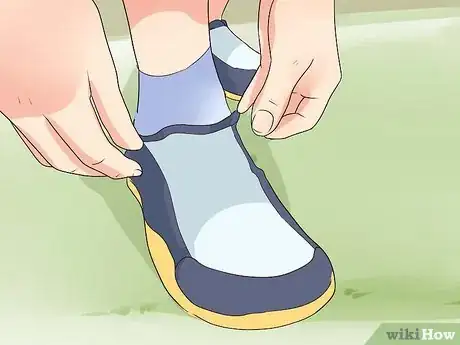
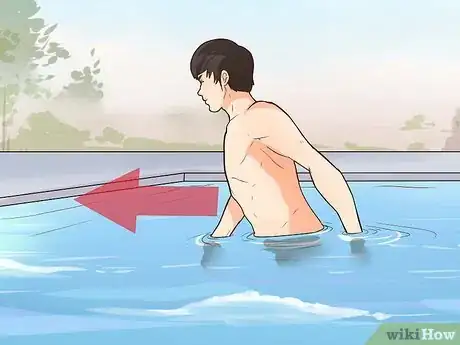

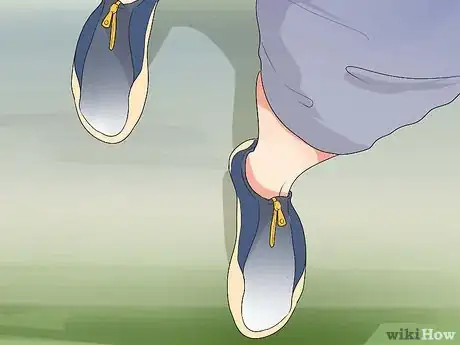
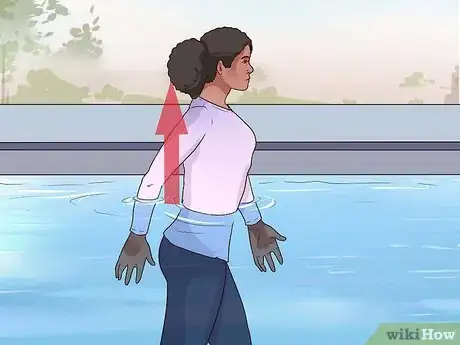
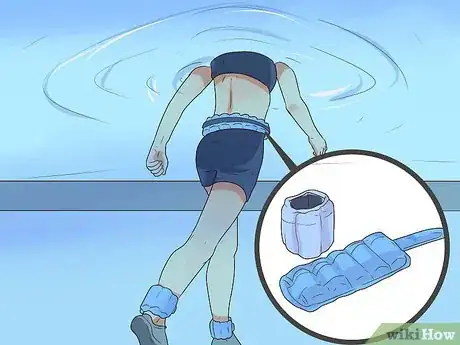
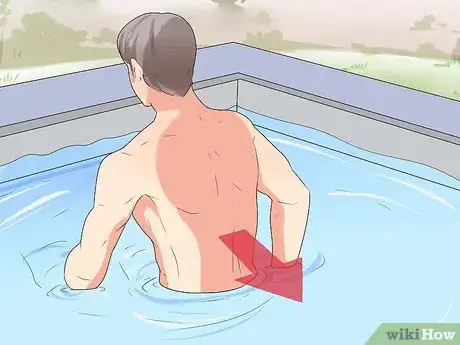
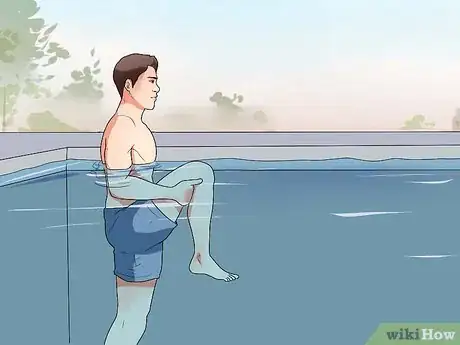
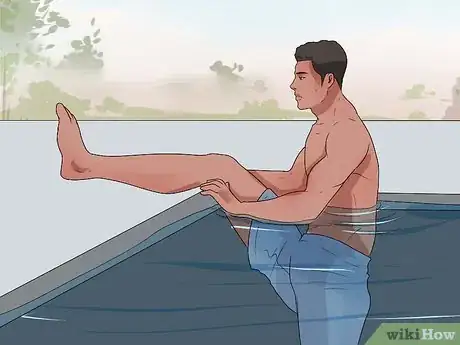
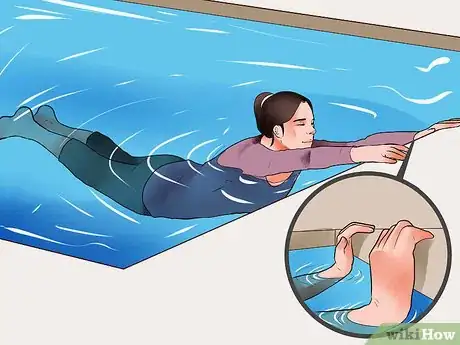
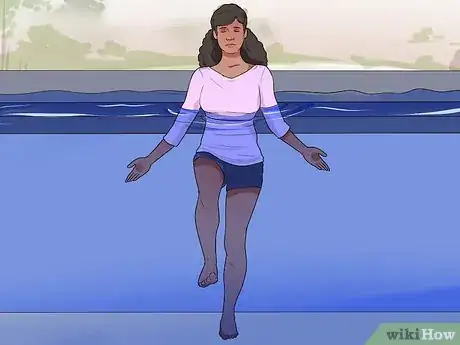
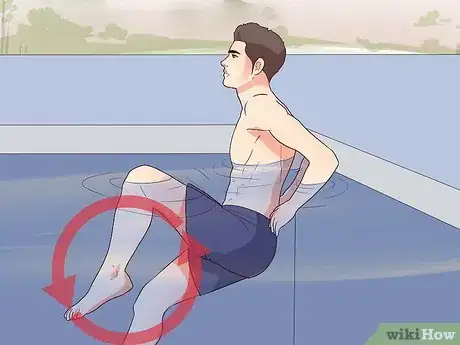
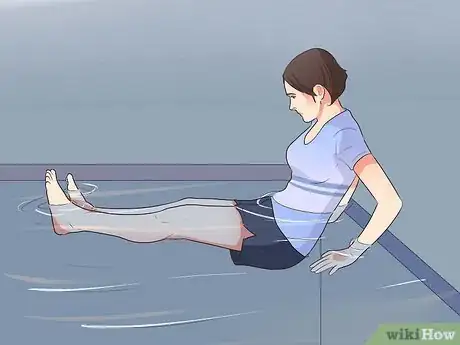
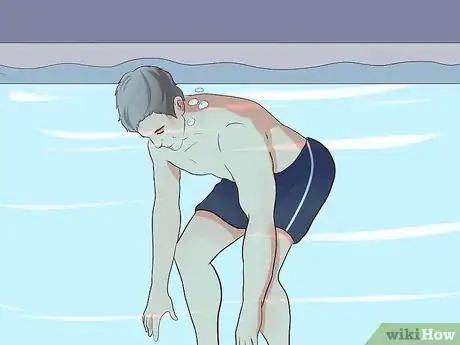
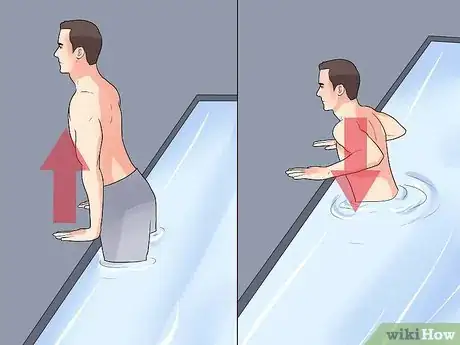
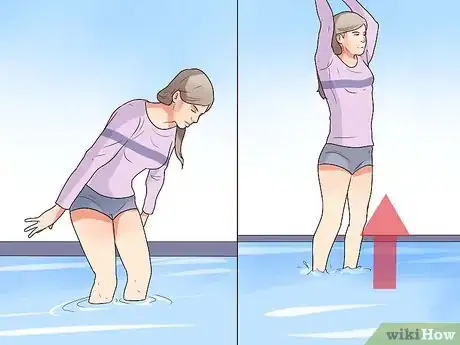
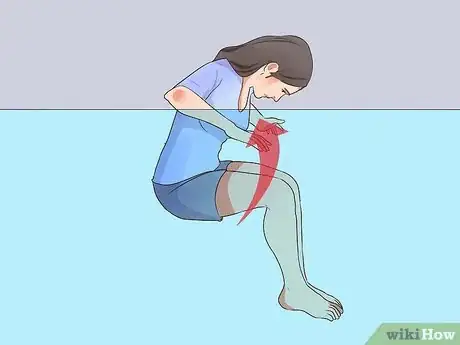
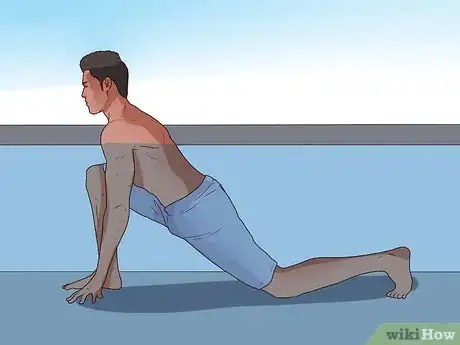
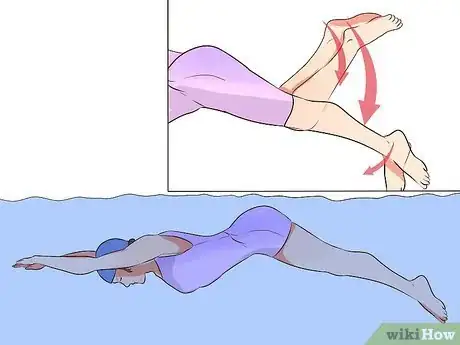
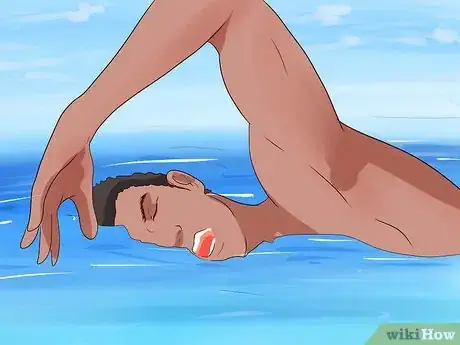



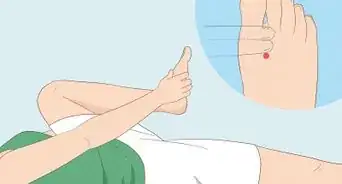




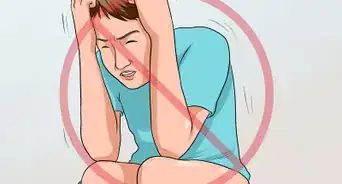














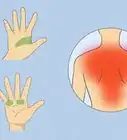






































Medical Disclaimer
The content of this article is not intended to be a substitute for professional medical advice, examination, diagnosis, or treatment. You should always contact your doctor or other qualified healthcare professional before starting, changing, or stopping any kind of health treatment.
Read More...